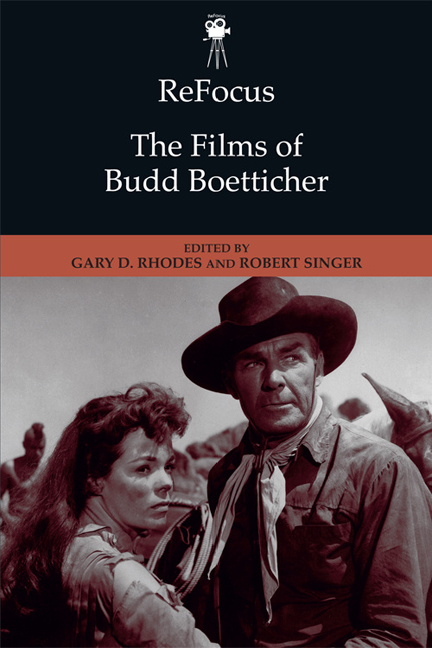Book contents
- Frontmatter
- Contents
- Notes on Contributors
- Dedication
- Introduction
- Part 1 The Non-Westerns
- Part 2 The Westerns
- Part 2 Introduction
- 7 The Ranown Cycle: Budd Boetticher's “New Look” Western Programmers in 1950s Hollywood
- 8 Framings, Motifs, and Floating Poker Games in Seven Men from Now (1956)
- 9 The Ranown Style: Mapping Textual Echoes
- 10 You Were Married, But You Never Had a Wife: The Use of Space in the Westerns of Budd Boetticher
- 11 Ideology and Boetticher's Westerns from the Late 1950s
- 12 Outlaws Without a Cause: Generational Conflict in Budd Boetticher's Ranown Cycle
- 13 The Box in the Desert: Budd Boetticher, Breaking Bad, and the Twenty-first-century Western
- Index
9 - The Ranown Style: Mapping Textual Echoes
from Part 2 - The Westerns
Published online by Cambridge University Press: 22 December 2017
- Frontmatter
- Contents
- Notes on Contributors
- Dedication
- Introduction
- Part 1 The Non-Westerns
- Part 2 The Westerns
- Part 2 Introduction
- 7 The Ranown Cycle: Budd Boetticher's “New Look” Western Programmers in 1950s Hollywood
- 8 Framings, Motifs, and Floating Poker Games in Seven Men from Now (1956)
- 9 The Ranown Style: Mapping Textual Echoes
- 10 You Were Married, But You Never Had a Wife: The Use of Space in the Westerns of Budd Boetticher
- 11 Ideology and Boetticher's Westerns from the Late 1950s
- 12 Outlaws Without a Cause: Generational Conflict in Budd Boetticher's Ranown Cycle
- 13 The Box in the Desert: Budd Boetticher, Breaking Bad, and the Twenty-first-century Western
- Index
Summary
A film begins with long shot of a distinctive rocky landscape, made up of huge, rounded boulders sticking up out of the parched earth. Distant snowy peaks appear faintly in the background, under a clear blue sky. Music provides an accompaniment, a minor refrain dominated by brass and backed by a persistent hollow-sounding kettledrum beat. Credits appear, a crudely shaped yellow typeface made to look as though it is fashioned from rock or wood. After a minute or so, a small figure on a horse emerges from among the rocks and the camera pans steadily to trace his movement through the terrain. The figure proceeds to ride across this precarious environment, picking his way through winding paths among the rocks and eventually towards the camera.
This description fits the opening moments of not one but two films directed by Budd Boetticher: Ride Lonesome (1959), and Comanche Station (1960). Indeed, the similarities of place, style and mood are so close in these first few minutes that they could almost be the same film. Watching the beginning of either film may evoke recognition of the other. Moreover, to watch one with knowledge of the other creates an enriched experience, beyond expectation or the pleasures of familiarity. The openings are formally and narratively spare but acquire density when considered in concert. The contiguity in ways of situating character, signaling relationship to genre, and opening the narrative constitutes not just a parallel but also an overlap. Between them, these films acquire layers that underline or thicken certain qualities, illuminating the shared sensibilities of the films.
This chapter will seek to explore how the films’ layering and accumulation, through repetitions and echoes, contribute to the dense texture of the world created in what Jim Kitses termed Budd Boetticher's “Ranown cycle.” The cycle—all collaborations with writer Burt Kennedy, star Randolph Scott and producer Harry Brown—consists of six Westerns directed by Boetticher between 1956 and 1960, four of which were shot in Lone Pine, California: Seven Men from Now (1956), The Tall T (1957), Ride Lonesome, and Comanche Station.
- Type
- Chapter
- Information
- ReFocus: The Films of Budd Boetticher , pp. 149 - 165Publisher: Edinburgh University PressPrint publication year: 2017

